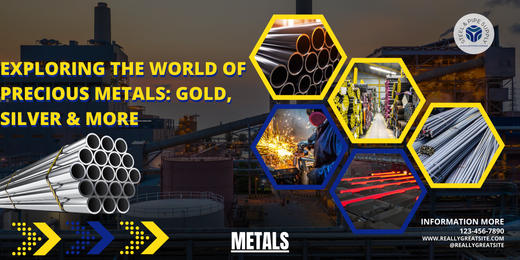
Exploring the World of Precious Metals: Gold, Silver & More
Share
Introduction
The allure of precious metals has captivated humanity for millennia, with gold and silver often regarded as symbols of wealth, power, and status. Gold, in particular, has a storied history that dates back to ancient civilizations. The Egyptians, for instance, revered gold not only for its beauty but also for its association with the divine.
The burial treasures of pharaohs, laden with gold artifacts, underscore its significance in religious and cultural practices. Similarly, the Incas of South America considered gold to be the "sweat of the sun," using it in religious ceremonies and adorning their temples. This historical reverence for gold laid the foundation for its role as a medium of exchange and a store of value.
Silver, while often overshadowed by gold, has also played a crucial role in human history. The use of silver as currency can be traced back to ancient Mesopotamia, where it was used in trade and commerce. The Greeks and Romans further popularized silver coins, which facilitated trade across vast empires.
The significance of silver extended beyond mere currency; it was also utilized in various applications, including medicine and photography. Other precious metals like platinum and palladium have gained prominence in more recent times, particularly in industrial applications and as investment vehicles. The historical significance of these metals is not merely a relic of the past; it continues to shape economic systems and cultural practices around the world.
Key Takeaways
- Gold and silver have been highly valued throughout history for their rarity, beauty, and usefulness in various applications.
- Investing in precious metals can provide a hedge against inflation and economic uncertainty, but it's important for beginners to understand the market and do thorough research.
- Precious metals play a crucial role in global economies, serving as a store of value, a medium of exchange, and a unit of account.
- The mining and refining process of precious metals can have significant environmental impacts, including deforestation, water pollution, and habitat destruction.
- The future of precious metals is influenced by trends such as technological advancements, changing consumer preferences, and global economic conditions.
Investing in Precious Metals: A Beginner's Guide
Why Invest in Precious Metals?
One of the primary reasons investors turn to precious metals is their ability to act as a hedge against inflation and economic uncertainty. Unlike fiat currencies, which can be printed at will by governments, precious metals have intrinsic value that tends to hold steady over time.
Forms of Precious Metals Investment
Investors can choose from various forms of precious metals, including bullion bars, coins, and exchange-traded funds (ETFs). Bullion bars are typically purchased for their weight in metal and are favored by serious investors looking to accumulate large quantities. Coins, on the other hand, often carry numismatic value in addition to their metal content, making them appealing to collectors. ETFs provide a more accessible way for individuals to invest in precious metals without the need for physical storage.
Choosing the Right Option
Each option has its advantages and disadvantages, and potential investors should carefully consider their financial goals and risk tolerance before diving into this market.
The Role of Precious Metals in Global Economies
Precious metals play a multifaceted role in global economies, serving as both investment assets and critical components in various industries. Central banks around the world hold significant reserves of gold as part of their monetary policy strategies. These reserves act as a buffer against economic instability and currency fluctuations.
For instance, during periods of geopolitical tension or financial crises, central banks may increase their gold holdings to bolster confidence in their currencies. This practice underscores gold's enduring status as a safe-haven asset. In addition to their monetary functions, precious metals are integral to numerous industries.
Silver is widely used in electronics due to its excellent conductivity, while platinum and palladium are essential in catalytic converters for automobiles. The demand for these metals in industrial applications can significantly influence their market prices. Furthermore, the jewelry industry remains a substantial consumer of gold and silver, with cultural traditions driving demand across different regions.
The interplay between investment demand and industrial usage creates a dynamic market that reflects broader economic trends.
The Process of Mining and Refining Precious Metals
| Stage | Process | Metric |
|---|---|---|
| Mining | Extraction of ore from the earth | Tons of ore extracted |
| Crushing and Grinding | Breaking down the ore into smaller pieces | Particle size distribution |
| Leaching | Using chemicals to extract metals from ore | Concentration of metal in solution |
| Refining | Purifying the metal to remove impurities | Purity percentage |
The journey of precious metals from the earth to the marketplace is a complex process that involves several stages: exploration, extraction, refining, and distribution. Mining operations often begin with extensive geological surveys to identify potential deposits. Once a viable site is located, companies must navigate regulatory frameworks and secure permits before commencing extraction.
Mining techniques vary depending on the type of metal being extracted; for example, gold is often mined through open-pit or underground methods. Once extracted, the raw ore undergoes refining to separate the metal from impurities. This process can involve several methods, including smelting and electrolysis.
Smelting involves heating the ore to high temperatures to separate the metal from its ore through chemical reactions. Electrolysis uses electrical currents to extract pure metal from solutions containing metal ions. The refining process is crucial not only for obtaining high-purity metals but also for minimizing environmental impacts by reducing waste and energy consumption.
The Use of Precious Metals in Jewelry and Art
The aesthetic appeal of precious metals has made them a staple in jewelry design and artistic expression throughout history. Gold and silver have been used to create intricate pieces that symbolize love, status, and cultural identity. In many cultures, gold jewelry is not only a fashion statement but also an investment that can be passed down through generations.
The craftsmanship involved in creating these pieces often reflects cultural heritage and artistic traditions. In addition to jewelry, precious metals have found their way into various forms of art. Artists have utilized gold leaf in paintings to create luminous effects that enhance visual depth.
Silver has been employed in sculpture and decorative arts due to its malleability and reflective properties. The use of precious metals in art transcends mere aesthetics; it often carries symbolic meanings that resonate with viewers on multiple levels. As contemporary artists continue to explore innovative ways to incorporate these materials into their work, the legacy of precious metals in art remains vibrant.
The Environmental Impact of Precious Metal Mining
The Environmental Impact of Mining Operations
The allure of precious metals is undeniable, but the environmental consequences of mining operations cannot be overlooked. Mining activities can lead to significant ecological disruption, including habitat destruction, soil erosion, and water pollution. The extraction process often involves the use of toxic chemicals such as cyanide and mercury, which can contaminate local water sources and pose health risks to nearby communities.
Adopting Sustainable Mining Practices
Efforts are being made within the industry to mitigate these impacts through sustainable mining practices. Companies are increasingly adopting technologies that reduce waste generation and improve resource efficiency. For instance, some operations are implementing closed-loop systems that recycle water used in processing ore.
Responsible Sourcing and Community Engagement
Additionally, there is a growing emphasis on responsible sourcing practices that prioritize environmental stewardship and community engagement. As consumers become more aware of these issues, there is an increasing demand for ethically sourced precious metals that align with sustainable values.
A Shift Towards Sustainable Values
This shift towards sustainable values is driving change within the industry, as companies strive to balance their economic goals with environmental and social responsibilities.
The Future of Precious Metals: Trends and Forecasts
The future landscape of precious metals is shaped by various factors ranging from technological advancements to geopolitical developments. One notable trend is the increasing interest in digital assets backed by precious metals. Cryptocurrencies like Bitcoin have garnered attention as alternative investments; however, some investors are exploring digital tokens that represent ownership of physical gold or silver.
This fusion of traditional assets with modern technology could redefine how individuals invest in precious metals. Moreover, the ongoing transition towards renewable energy sources is likely to impact the demand for certain precious metals significantly. Silver's role in solar panel production positions it as a critical component in the green energy revolution.
Similarly, platinum group metals are essential for hydrogen fuel cells and other clean technologies. As global economies shift towards sustainability, the demand dynamics for precious metals will evolve accordingly.
Conclusion
The world of precious metals encompasses a rich tapestry of history, investment opportunities, industrial applications, and environmental considerations.As society continues to navigate economic uncertainties and technological advancements, understanding the multifaceted nature of these metals will be crucial for investors, consumers, and policymakers alike.

